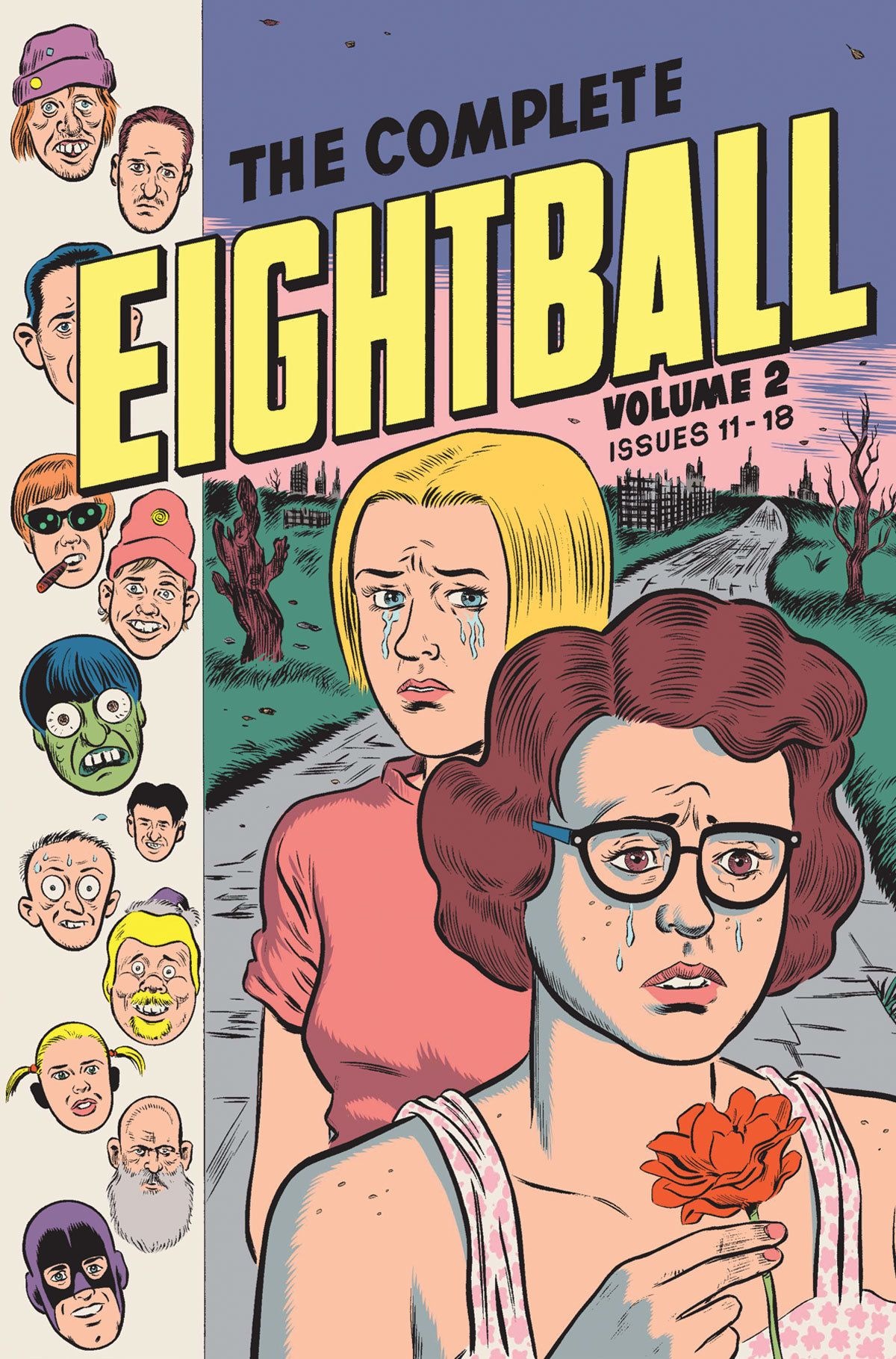
Let’s leave off this week with a glorious image. Eightball ran for 18 issues from 1989 to 1997 and was the medium for such classics as “Art School Confidential”, “Live a Velvet Glove Cast in Iron,” “Ghost World” Dan Pussey and more more more. Traversing the gulf from rough humor comics of the 80s to the intimate details of the 90s, it’s an essential for the smallest comics shelf possible. The book drops in June and Vice talks to The Man
“We came out of an era that was just moribund in comics.” Clowes says over the phone from his home in California. “The original guys who’d revitalised Marvel in the 60s had faded, and they were replaced by guys imitating them, who were then replaced by guys imitating them, it was this fourth generation of boring, awful comics. At the same time all the head shops, all the drug paraphernalia shops were being closed down – and they were where underground comics by the likes of Robert Crumb would be sold, so that was disappearing as well. There was nothing, it felt dead. But there was a whole generation of us who’d grown up on Mad magazine and National Lampoon and the comedy of Monty Python and Richard Pryor, and we wanted to do good comics. All of a sudden these people started to appear all over the country, trying to do something different, it was a miracle that we got an audience. We were a very, very small offshoot of the comics industry – it didn’t feel like we were taking over anything…”
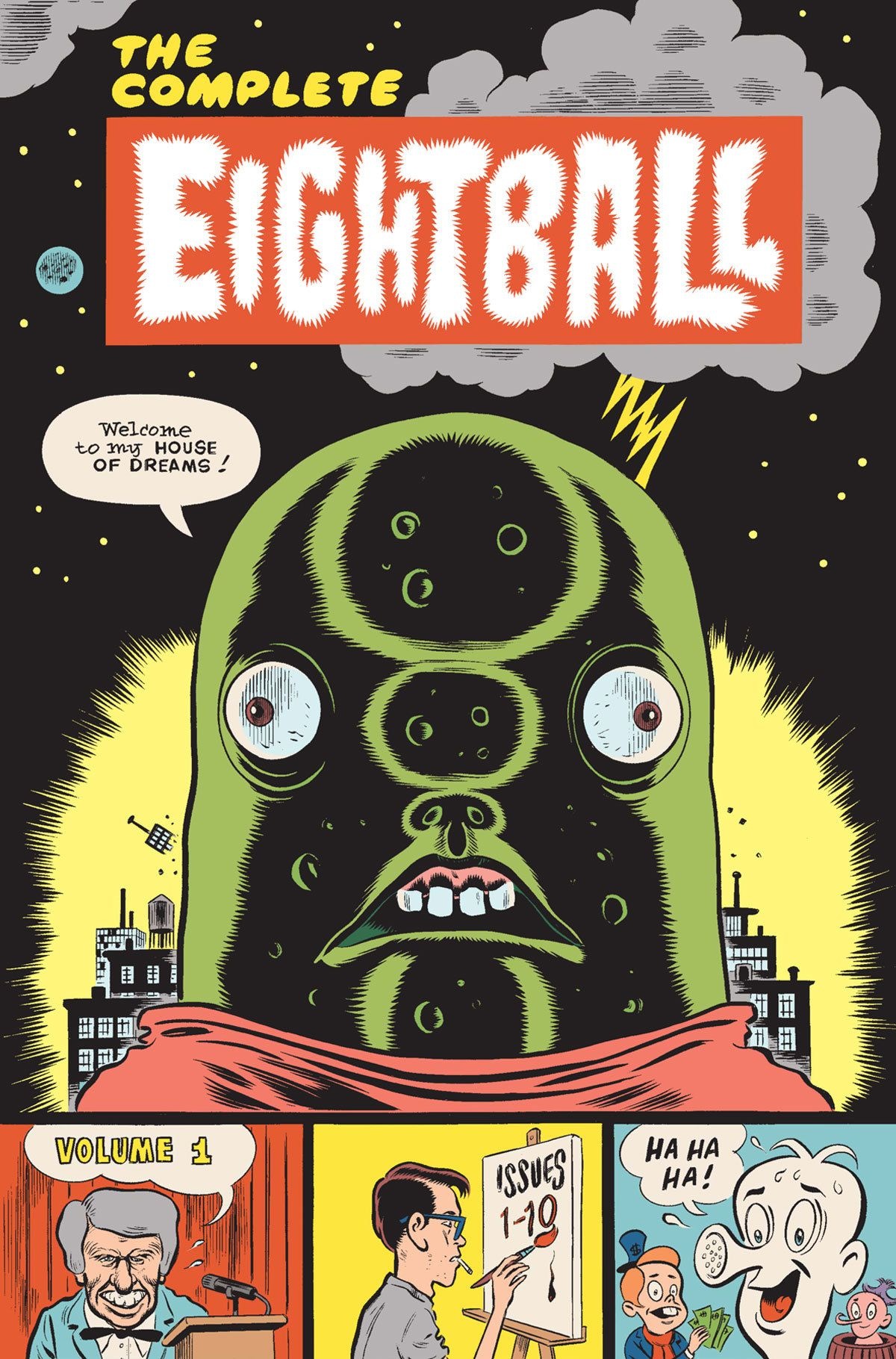
You’d be forgiven if you think of Matt Kindt as a breakaway success, since the “slow and steady” approach that’s defined his career so far looks like a sprint to the finish line with the explosive success of MIND MGMT from Dark Horse. Educator and author Travis Langley (Batman and Psychology) sat down with Kindt in a marathon 90 minute interview panel with the enigmatic creator on March 30th as part of the Comic Arts Conference at WonderCon. This “Focus” series event revealed just how long a road it has been for Kindt to reach his current level of exposure and fandom with MIND MGMT, a comic series about the dark legacy of a government spy agency staffed by agents with psychic abilities.
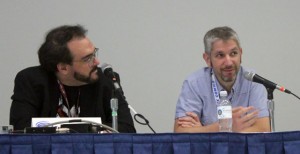 Kindt, who says he’s probably been best know for his graphic novel SUPERSPY prior to MIND MGMT, had an unusual experience with comics at the age of 7 or 8 years old that left a big impression on him and still continues to influence his work. Reading Frank Miller’s DAREDEVIL, he ploughed through an entire issue where Daredevil visits Bullseye in the hospital, now paralyzed (following his murder of Elektra) and repeatedly pulls the trigger on his gun at the murderer. The issue itself consists of Daredevil speaking to the comatose Bullseye with almost no action at all, and as a kid Kindt thought “What kind of crazy superhero stuff is this?”. The heavy, odd dialogue and the “threat” of the unloaded gun, Kindt said, “made me love comics”. After a period in the 90’s when superhero books weren’t “capturing” Kindt’s attention anymore, he had another epiphany after discovering Daniel Clowes’ series EIGHTBALL at a con. He immediately felt, upon reading the issues, “This is the kind of comics I want to do” and an indie sensibility was born. Enter the years of hard work and learning just how to produce comics with his own particular voice.
Kindt, who says he’s probably been best know for his graphic novel SUPERSPY prior to MIND MGMT, had an unusual experience with comics at the age of 7 or 8 years old that left a big impression on him and still continues to influence his work. Reading Frank Miller’s DAREDEVIL, he ploughed through an entire issue where Daredevil visits Bullseye in the hospital, now paralyzed (following his murder of Elektra) and repeatedly pulls the trigger on his gun at the murderer. The issue itself consists of Daredevil speaking to the comatose Bullseye with almost no action at all, and as a kid Kindt thought “What kind of crazy superhero stuff is this?”. The heavy, odd dialogue and the “threat” of the unloaded gun, Kindt said, “made me love comics”. After a period in the 90’s when superhero books weren’t “capturing” Kindt’s attention anymore, he had another epiphany after discovering Daniel Clowes’ series EIGHTBALL at a con. He immediately felt, upon reading the issues, “This is the kind of comics I want to do” and an indie sensibility was born. Enter the years of hard work and learning just how to produce comics with his own particular voice.
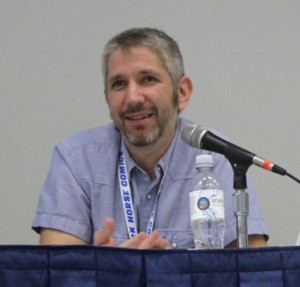 Kindt’s education in fine art and painting, still evident in his comics work, influenced him tremendously in making comics, he told Langley. To “know production” and “have control of every part of the process” of making comics now serves him well, but as an art student at Webster University, he “kept comic books a secret”, since they were not considered an “art form” by his instructors. The most rewarding skill he acquired, Kindt explained, turned out to be print-making. Even though it’s not a “discipline directly related”, its application to comics proved invaluable. “It helped me think about color and composition”, he said, and through print making he acquired one of his key concepts when it comes to making comics, “movement in production”, a phrase his print making instructor used that “still haunts” him. For Kindt, “movement in production” means not being “precious” about a particular stage of production and reminds him not to “hold onto things” but keep his comics output moving. It results in the fairly profound productivity readers see today from Kindt.
Kindt’s education in fine art and painting, still evident in his comics work, influenced him tremendously in making comics, he told Langley. To “know production” and “have control of every part of the process” of making comics now serves him well, but as an art student at Webster University, he “kept comic books a secret”, since they were not considered an “art form” by his instructors. The most rewarding skill he acquired, Kindt explained, turned out to be print-making. Even though it’s not a “discipline directly related”, its application to comics proved invaluable. “It helped me think about color and composition”, he said, and through print making he acquired one of his key concepts when it comes to making comics, “movement in production”, a phrase his print making instructor used that “still haunts” him. For Kindt, “movement in production” means not being “precious” about a particular stage of production and reminds him not to “hold onto things” but keep his comics output moving. It results in the fairly profound productivity readers see today from Kindt.
Another benefit of studying fine arts, Kindt said, was to “learn about everything” and learn to make art before learning to make comics. Learning to make comics from observing comics is fine, he assured the audience, but it is “limiting the scope of how you think about comics”. Kindt, who’s known for his use of watercolor and tirelessly inventive design of marginalia in his work, is a pretty good living example of his point. By bringing in tools and tricks learned in other art forms, he expands awareness for readers and creators about what the comics format can do.
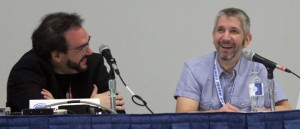 Kindt told Langley that he started off self-producing mini comics after attending ‘zine shows and first learned there about the common saying that a comics artist has to produce a thousand pages before they really produce one good one. The idea stayed with him as he watched his page count climb over the years. Inspired by autobio comics, he started producing them, meanwhile working his “boring day job”. “Every job was boring to me if I was not doing comics”, he confessed, and added that for him, “Everything has to have a dual purpose”. He worked in cinemas and bookstores to get discounts and continue to explore new artistic influences as part of his “dual purpose” of producing comics.
Kindt told Langley that he started off self-producing mini comics after attending ‘zine shows and first learned there about the common saying that a comics artist has to produce a thousand pages before they really produce one good one. The idea stayed with him as he watched his page count climb over the years. Inspired by autobio comics, he started producing them, meanwhile working his “boring day job”. “Every job was boring to me if I was not doing comics”, he confessed, and added that for him, “Everything has to have a dual purpose”. He worked in cinemas and bookstores to get discounts and continue to explore new artistic influences as part of his “dual purpose” of producing comics.
 After graduating from college, Kindt worked at a “small design firm” and “hated it” despite the fact that it was art related. The “cubicle” environment depressed him and so he would speed through his required work and then “blatantly write comics after the work was done”. He rather ingeniously drafted and planned the comics while at work, so once home, “pages were ready to draw”. Kindt’s answers during this part of the interview were particularly funny as he broke into detailed narratives, but the most memorable vignette concerned using company color photocopiers to produce his comic covers after hours. “I don’t recommend this”, he warned regarding this strategy. Using special, thick paper for the covers, Kindt patiently kept copying despite the fact that the printer would jam every few copies. Finally, one cover “melted to the copier”, imprinting the drum of the copier with the cover image, including his name in clear script. After panicking, then realize there was simply nothing he could do about it, he knew he was “screwed” and left it. He returned to work without saying anything about it, watched the copier being repaired, and waited for the shoe to drop. It never did. His employers, for whatever reason, decided to turn a blind eye.
After graduating from college, Kindt worked at a “small design firm” and “hated it” despite the fact that it was art related. The “cubicle” environment depressed him and so he would speed through his required work and then “blatantly write comics after the work was done”. He rather ingeniously drafted and planned the comics while at work, so once home, “pages were ready to draw”. Kindt’s answers during this part of the interview were particularly funny as he broke into detailed narratives, but the most memorable vignette concerned using company color photocopiers to produce his comic covers after hours. “I don’t recommend this”, he warned regarding this strategy. Using special, thick paper for the covers, Kindt patiently kept copying despite the fact that the printer would jam every few copies. Finally, one cover “melted to the copier”, imprinting the drum of the copier with the cover image, including his name in clear script. After panicking, then realize there was simply nothing he could do about it, he knew he was “screwed” and left it. He returned to work without saying anything about it, watched the copier being repaired, and waited for the shoe to drop. It never did. His employers, for whatever reason, decided to turn a blind eye.
The job provided “motivation” for Kindt due to his profound desire to get away from an office job. He knew at the time, he said, “I’ll never be happy”. He was aware that he needed to “either fail or succeed at the thing I wanted to do most”. “Mocking” copies up at Kinkos at twenty dollars a piece, he printed 20 books and physically took the books to Dark Horse, Top Shelf, and Fantagraphics booths at a show in Chicago. By this time, Kindt had moved beyond autobio comics because he was getting a sense of “horrible feedback” from spending all day at a job he hated and then writing about it again in his comics. From making a list of things he wanted to draw, he concocted stories to allow him to do it. The list, he said (to laughter from the audience) included pirates, elements of old radio shows, and circus freaks. After handing over the hard-won comics to publishers, Kindt was more than amazed to receive a phone call at home. For Kindt, he still remembers the call as his “greatest moment”. Top Shelf wanted the book, “just as it is”. Ironically, the only change they wanted to make was to the melted cover.
 Kindt went on to learn a host of lessons in an uphill struggle to make a living in comics, from realizing that collaboration was just not his thing, to challenging himself (never again, he said) to create an entire graphic novel without a single narrative box, resulting in a 300 page tome, to the realization that with his book SUPERSPY, he had finally reached his 1000th page. Just on time, SUPERSPY took off in ways his previous critically acclaimed works had never managed to achieve.
Kindt went on to learn a host of lessons in an uphill struggle to make a living in comics, from realizing that collaboration was just not his thing, to challenging himself (never again, he said) to create an entire graphic novel without a single narrative box, resulting in a 300 page tome, to the realization that with his book SUPERSPY, he had finally reached his 1000th page. Just on time, SUPERSPY took off in ways his previous critically acclaimed works had never managed to achieve.
Langley then led Kindt into the spy-obsessing portion of the interview, one which provoked a great deal of enthusiasm from the audience. Kindt, surprisingly, said that his espionage-based current work MIND MGMT, is not “really about spies”. He confessed that spy literature and film formed an early influence on his life from a family-bonding trip to a drive-in theatre to see MOONRAKER onward. The travel-writing aspect of spy novels were what Kindt found particularly appealing, churning through all the works of Ian Fleming as a teen. When he reads spy books or watches films now, however, he has a particular strategy in mind. He’s deciding what he’s “not going to put in books” since they’ve already been done by a process of “elimination”.
Kindt’s books now, and increasingly, show his obsession with “gadgetry” to the point that even close personal friends in comics (he mentioned Cullen Bunn and Jeff Lemire as examples) tease him about it, but it’s all part of the “physicality” and “interactive” aspects of printed comic books that appeals to Kindt. MIND MGMT is Kindt’s first fully serialized work where he is functioning as both writer and artist, and he’s taken advantage of that fact to emphasize the capabilities unique to print books, loading the inner covers of the comic, for instance, with extras for fans of spy lore. MIND MGMT contains features like a “field guide” format to its borders, Kindt explained, as if the comic is being presented within a field guide for secret government agents. Kindt also revealed that he’s particularly passionate about the role of covers in printed comics as the “very first page of the story” that has to function and work as simply a cover but also “work in a narrative way”.
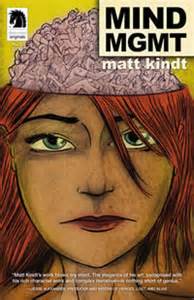 Though the question and answer period was generous and wide-ranging, covering his artistic processes, research for his books, and upcoming plans for MIND MGMT, Kindt’s passion for printed comics became a particularly hot topic. Working on a monthly book that is available in digital formats but contains incentives for print collection helps “get people back into shops every week”, Kindt explained, and may lead to readers discovering new books they like along the way rather than simply waiting for trades. He’s not averse to digital formats, he assured the audience, and reads many comics in digital format, but as a designer he’s concerned that “digital should be designed to be digital” and is not a fan of simple relocation of formats without attention to detail.
Though the question and answer period was generous and wide-ranging, covering his artistic processes, research for his books, and upcoming plans for MIND MGMT, Kindt’s passion for printed comics became a particularly hot topic. Working on a monthly book that is available in digital formats but contains incentives for print collection helps “get people back into shops every week”, Kindt explained, and may lead to readers discovering new books they like along the way rather than simply waiting for trades. He’s not averse to digital formats, he assured the audience, and reads many comics in digital format, but as a designer he’s concerned that “digital should be designed to be digital” and is not a fan of simple relocation of formats without attention to detail.
I asked Kindt, as the final question of the panel, what psychic powers he would like to have if he could somehow acquire them. His list was as down-to-earth as the hour and a half chat he shared with WonderCon goers: remember peoples’ names and be less oblivious. “I’d make the worst spy”, he confessed, “I can’t remember anything”. All a ploy to throw fans off the scent? Hearing a portion of the full story behind Kindt’s seemingly meteoric rise makes something clear once again about working in comics: it entails work, work, work, and more work, but it also demands commitment and passion. It’s not an easy combination to emulate, but for Kindt it’s been the only way to be truly happy.
Photo Credits: All photos in this article were taken by semi-professional photographer and pop culture scholar Michele Brittany. She’s an avid photographer of pop culture events. You can learn more about her photography and pop culture scholarship here.
Hannah Means-Shannon writes and blogs about comics for TRIP CITY and Sequart.org and is currently working on books about Neil Gaiman and Alan Moore for Sequart. She is @hannahmenzies on Twitter and hannahmenziesblog on WordPress.











“and was the medium for such classics”
What a strange use of words. Eightball is a “medium”? Perhaps you meant, more accurately, say, “vehicle”? Breathe on, mouth, breathe on.
Also, Eightball ran 23 issues, not 18. Facts, I realize they don’t matter.
And on top of that, this isn’t the cover for the book, the cover was already revealed a few months ago. These are the covers for the individual volumes within the set. But yeah, a great reminder of why I stopped reading this blog, particularly the points Patrice singles out… To me, the site looks great and the range of what’s covered is pretty perfect for what the site is, but the writing is consistently atrocious – full of wrong information (all the more annoying for the “yeah, I know what I’m talking about” tone), constant typos and always weirdly jumbled.
My Man, Bleh!
“a great reminder of why I stopped reading this blog”
I think it’s all well and good to add a correction, but the previous four comments are a great reminder of why I’m so disappointed in humanity when I read comments on virtually every page of the Internet. The world snipes at comics fans enough without us sniping at ourselves.
Eightball 1-18 were an anthology of Clowes’ work, the next five were different, the next three being one story, and the next two being standalone stories. Hey, did the writer of this article not pick them up as floppies 15 years ago? Some people think the best course of action is to be obnoxious about informing them. Maybe she’s read them in trade, maybe she hasn’t read them all but felt that she liked what she’d read of his enough to make it worth posting. She’s giving promotion to one of the better comics artists ever, that doesn’t get that much promotion when he’s not being nominated for an Oscar.
Personally, I’m happier that Clowes is posted about on a relatively mainstream site, much more than I’m bitter that some details are wrong. Next time, try checking IGN comics or Comicsvine for your Clowes news. And try not being a terrible person tomorrow. You can do it if you try.
I miss Lloyd Llewellyn. Would love to see the LLLL stories in an animated series.
I hate it when free things don’t live up to my expectations.